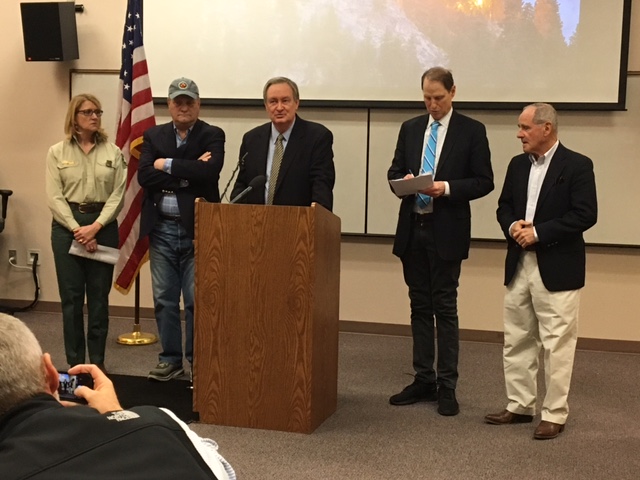Bipartisan legislation lead by Idaho delegation reforms national public lands fire fighting
Members Attend Briefing Focused on Preparedness in Wake of Recently-Passed Bill Ending Practice of Fire Borrowing
BOISE – After more than five years of bipartisan collaboration, Idaho Senators Mike Crapo and Jim Risch joined Idaho Congressman Mike Simpson today at the National Interagency Fire Center (NIFC) to mark the end of the practice known as fire borrowing. Joining the delegation was Vicki Christiansen, Acting Chief of the U.S. Forest Service. Oregon Senator Ron Wyden, who worked with Crapo and Risch was also on hand for the briefing.
The practice of fire borrowing ended under provisions included in the omnibus spending bill passed by Congress in late March. As wildfires intensify across the West, wildland firefighting costs are escalating and often far exceed budget estimates. The National Interagency Fire Center reports that suppression costs have increased from nearly $240 million in 1985 to more than $2.9 billion in 2017. This has resulted in agencies, such as the U.S. Forest Service and U.S. Bureau of Land Management diverting funds from important projects that improve the health of our forests and enable recreational activities on our public lands to covering pressing wildfire suppression costs. This practice, known as fire borrowing, resulted in less resources for the very activities that can prevent large, devastating fires, and the harmful fire cycle worsens as forest health projects are tabled. The recently enacted law not only improves federal budgeting for wildfires by permitting disaster relief funds to be accessed when fire suppression expenditures exceed their 10-year average, but also includes forest management reforms that will result in significant positive impacts on forest health.
“This has been a bipartisan bill and a bicameral bill from the outset,” said Crapo during the briefing. “The battle we have been fighting is that catastrophic fires --one percent of the fires that absorb nearly 30 percent of the firefighting costs—have not been recognized by Congress as natural disasters or been given the funding support that they need. That has forced our agencies into the very difficult circumstance of fire borrowing, which took away from the other functions of the forest service and the Bureau of Land Management.”
"We’ve redone the way that firefighting is going to be funded, to free up the agency’s money to be used for what it should be used for - and that is land management,” Risch said at the press conference. "This has not been a Republican versus Democrat issue – it has been a great, bipartisan team effort."
“This is perhaps the most important piece of legislation Congress has passed to help the Forest Service in the last 50 years,” said Simpson. “If we had not passed this bill, the Forest Service would have seen their fire costs grow to over 67 percent, essentially making them the Fire Service, and further decimating important programs, like trails maintenance, grazing, and recreation. Between the fire borrowing fix and the management reforms, we are giving land management agencies the tools to help prevent catastrophic fires.”
According to NIFC predictions, large parts of the western U.S. are predicted to have above average potential for significant wildfire activity this year. The "National Significant Wildland Fire Potential Outlook," released May 1st, predicts above average significant wildland fire potential in about a dozen Western states at various times between now and the end of August, including Arizona, California, Colorado, Idaho, Kansas, Montana, Nevada, New Mexico, Oregon, Texas, Utah, and Washington.
"By mid-summer, we expect warmer and drier than average conditions, large amounts of grass, melting of below average snowpack, and increasing potential for thunderstorm activity and lightning starts to create above average potential for significant wildfire activity in a large part of the western U.S.," said Ed Delgado, National Program Manager, Predictive Services, NIFC, adding that wildland fire potential depends on weather and fuel conditions, which can and often do change. As a result of these changes, NIFC issues an updated Outlook on the first day of each month. The number of wildfires and acres burned annually depends not only on wildland fire potential, but also on the number and timing of lightning and human caused ignitions.

